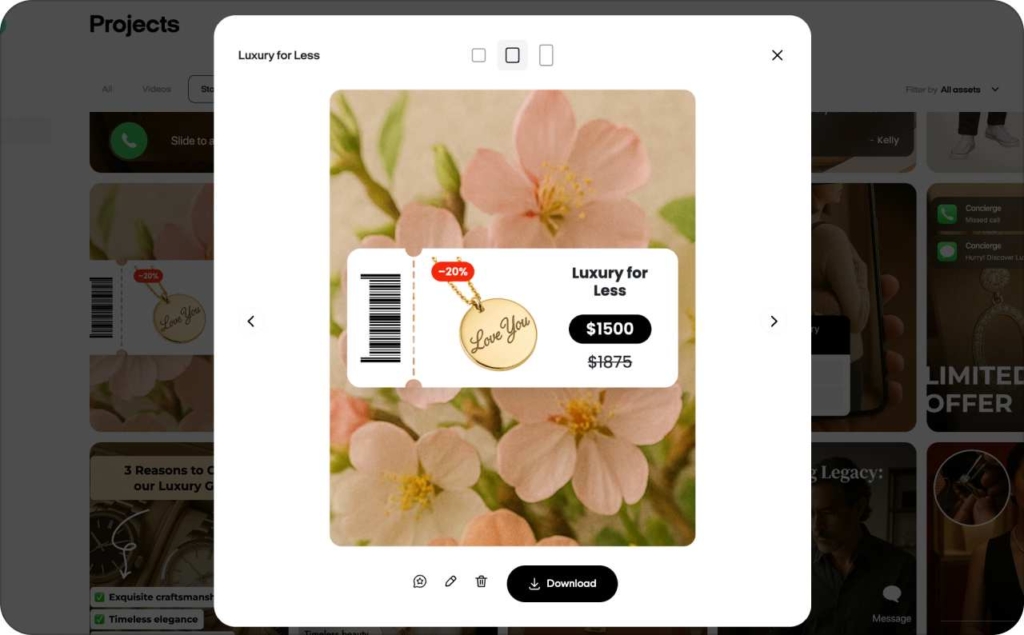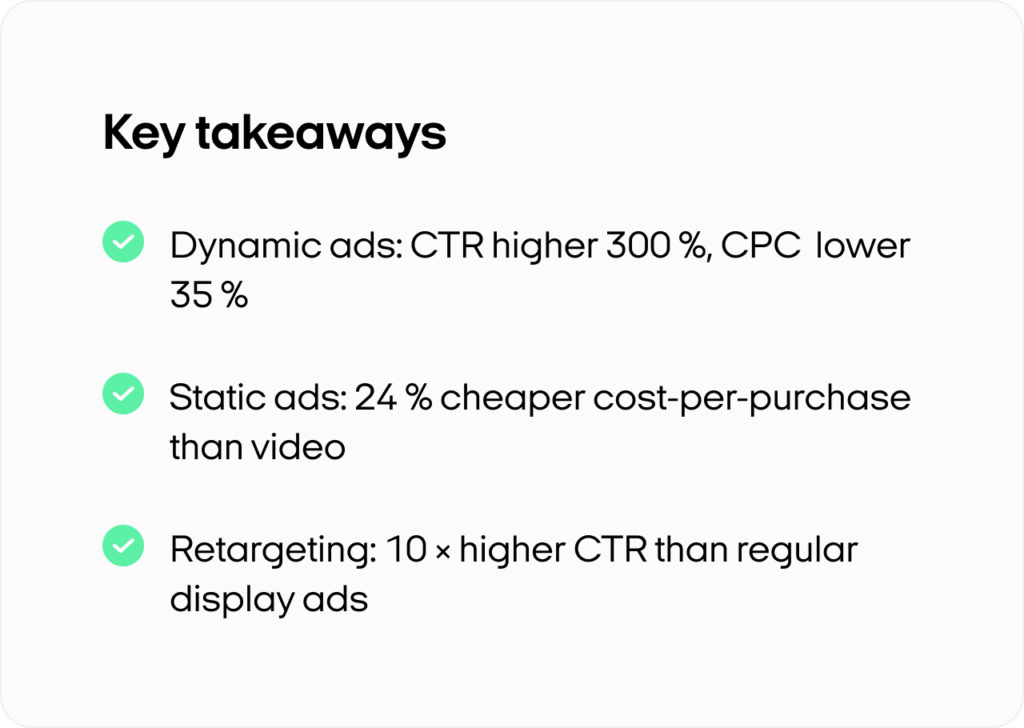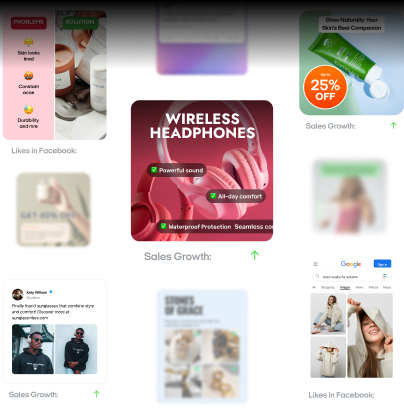Static ads vs. Dynamic ads: 5 key metrics to help you choose
Are dynamic ads really worth the hype or do static visuals still win? Discover the five metrics every marketer should track before deciding.
You know that choosing the wrong display ad format can quickly drain your budget, weaken your brand awareness, and derail your retargeting efforts. If you’re juggling tight budgets, brand-building campaigns, or major retargeting goals, deciding between static ads and real-time dynamic ads can completely change your results.
Keep in mind that global advertising revenue is expected to soar to $1.1 trillion by 2025 — meaning competition is getting fiercer. In this guide, you’ll learn how to align static and dynamic approaches with your unique campaign objectives, funnel stage, and budget constraints.
You’ll also discover how to blend static ads’ brand consistency with dynamic ads’ personalization, tackle common pitfalls like overspending on complex setups, and come away with ready-to-use strategies you can put into action immediately.

About static ads
You’ll find that static ads deliver the same creative to every viewer. They’re all about reinforcing brand identity and consistent messaging, rather than offering real-time personalization. That focus makes them an ideal choice for top-of-funnel campaigns, tighter budgets, or any scenario where you want a uniform look across platforms.
Definition & characteristics
When you rely on non-personalized advertising, you provide a stable creative that your audience learns to recognize quickly. Think of it like a classic billboard that never changes and always conveys a single, memorable idea.
Often referred to as fixed content ads or static banner ads, these formats help you protect your brand representation, particularly if you don’t need the complexity of data feeds or frequent updates.
Most platforms still support static ads. However, Instagram recently switched from a 1:1 aspect ratio to 4:5 (1080 x 1350 px) for vertical feed posts. If you have older square templates, you’ll want to resize them to fit this new layout.
Pro tip: Stick to the 4:5 format (1080 x 1350 px) for feed posts, and make sure you update older 1:1 templates. By keeping your visuals, messaging, and tone consistent across all static ads, you’ll strengthen brand recall and ensure your audience knows exactly who you are.
Pros of static ads
One of the biggest perks of using static ads is cost-effectiveness. You skip the complexities of dynamic tracking or personalization, which helps you keep technical expenses to a minimum. You also maintain total creative control, defining exactly how each ad looks, so your brand identity remains crystal-clear.
That consistency can be a game-changer in visually driven markets where customers rely on recognizable branding for their buying decisions. With fewer moving parts, there’s less chance of glitches, allowing your campaign to run more smoothly and keep your message front and center.

About dynamic ads
If you need high-relevance advertising that adapts instantly, dynamic ads have you covered. They rely on real-time ad customization, using user data and behavioral signals to tailor offers for each viewer. This data-driven approach makes them a top pick for marketers, particularly in the mid to bottom of the funnel where people are closer to making a purchase.
Definition & characteristics
Also known as adaptive advertising or personalized display ads, dynamic ads update content automatically to show shoppers exactly what they’re interested in. They might feature items a visitor browsed just last night or swap out headlines and visuals based on recent user actions.
This behavior-based strategy is a go-to for retargeting. One fashion brand, for instance, saw a 25% boost in sales by displaying the very items shoppers left behind.
Real-time personalization can pay off big, but it isn’t without risks. Your product feeds must stay current so you don’t push out-of-stock products. That’s why dynamic ads typically shine in mid- to bottom-funnel campaigns, where the right nudge can seal the deal for hesitant buyers.
Pros of dynamic ads
The top selling point is tailored messaging. You’re showing people the products or services that align with their recent activity, so there’s minimal guesswork involved. Automation is another big plus, using DCO, you can adjust everything from copy to images on the spot, as long as you maintain clean data to avoid any awkward mix-ups.
According to Forbes, nearly 97% of visitors who see your content aren’t ready to buy yet, which is exactly why dynamic ads shine in mid-funnel retargeting. By offering relevant reminders and deals, you can nurture leads until they’re ready to make a purchase.
Although the setup costs can run higher, many brands find the investment worthwhile. When you serve people exactly what they want your return on ad spend goes up, turning casual browsers into loyal customers.
Static vs. dynamic ads: Key differences & comparison
Choosing between cost-effective static ads and high-performing dynamic ads can feel overwhelming. This overview shows you how each format stands out in setup, cost, targeting, and metrics.
A growing number of ecommerce brands now rely on dynamic ads for retargeting, highlighting the push toward personalized advertising. Still, if you’re working with a tight budget or running straightforward promotions, static ads can be a reliable ally.
Content & setup complexity
- Static ads
You’ll use one fixed design for static ads, which makes them quick to create and easy to manage. Smaller teams or local businesses often find this no-fuss approach ideal - Dynamic ads
With dynamic ads, you adapt content based on user data or product feeds. They’re more complex to set up, but they deliver personalized offers that can grab attention more effectively
Bridging note: Now that you’ve seen how each format is built, let’s compare their cost and targeting.
Cost & targeting options
- Static ads
They’re usually more budget-friendly because you don’t need real-time data or advanced setups. This broader targeting approach fits best at the top of your funnel, where you’re primarily focused on brand exposure - Dynamic ads
Expect higher costs due to the personalization aspect, but you also gain stronger targeting — particularly in the mid or bottom of your funnel. For instance, you can serve ads based on abandoned carts or recent searches, which offers a more relevant user experience
Note: Next, let’s look at how each format performs in terms of engagement and metrics.
Performance metrics & engagement
- Static ads
You’ll likely measure success through basic analytics like clicks, impressions, and CPA. This straightforward approach suits short-term awareness campaigns where simplicity is key - Dynamic ads
Dynamic ads can boost CTR by up to 300%. HubSpot also points out that personalizing offers to match user interests helps optimize ROAS. You might track conversion rates or even lifetime value for a deeper understanding of their impact
Comparison table
| Feature | Static ads | Dynamic ads |
| Content | Fixed, same for everyone | Personalized, changes based on data |
| Setup complexity | Quick, minimal | Higher, needs data integration |
| Cost | Lower, simple production | Higher, tied to personalization |
| Engagement | Modest, less interactive | Greater, tailored to user preferences |
| Tracking | Basic (clicks, impressions, CPA) | Advanced (CTR, ROAS, conversion rate) |
| Best use cases | Brand awareness, small promos | Retargeting, e-commerce, personalized offers |
Which should you choose?
Go with static ads if you’re after quick, low-cost campaigns aimed at broad awareness. They’re simple to produce and don’t require specialized tools.
On the other hand, dynamic ads offer higher engagement by using customized messages. They’re most effective in the mid to bottom of your funnel, nudging users toward action. A B2B SaaS brand, for example, could blend both strategies — using static ads for broad sign-ups and dynamic ads to retarget users who haven’t completed onboarding.
Testing tip: If you’re on the fence, try an A/B test. Launch a small static campaign and a dynamic variation, then compare CTR, CPA, and ROAS to see what resonates best.

Best practices for implementing static & dynamic ads
Looking to level up your display campaigns? Here’s how you can optimize static ads for brand awareness and dynamic ads for personalized engagement. Combine sharp visuals, concise messaging, and reliable data to guide users from their first impression all the way to a confident conversion.
Tips for maximizing static & dynamic ads
You can harness the power of static and dynamic ads to drive better conversions by focusing on three essential elements: striking visuals, a compelling call-to-action (CTA), and consistent brand identity. If your static ads aren’t bringing in clicks, you’re likely wasting a valuable budget—because even the most innovative platforms can’t fix weak imagery or a vague message.
Use high-quality imagery
You’ll grab attention faster with crisp, relevant images than with cluttered or blurry designs. Use bold, readable fonts (16px or larger) to highlight key details, and maintain strong color contrast — at least a 3:1 ratio — to ensure everyone sees what matters most.
One marketer saw a 25% lift in click-through rates just by upgrading to high-resolution product photos. When viewers can quickly understand your offer, they’re more likely to engage.
Refine your CTA
Skip generic wording like “Click Here.” Instead, try phrases such as “Unlock Your Discount” or “Grab Your Offer” to spark immediate interest. Place your CTA where people can’t miss it, and experiment with a bold font or a distinct color. Through A/B testing, one advertiser boosted click-through rates by 30% by comparing multiple CTA styles and sticking with the top performer.
Maintain brand consistency
Every ad should reflect the same colors, fonts, and logo so viewers recognize you right away. Static ads provide a steady brand presence, while dynamic ads can use data, like browsing behavior or location, to customize each impression. Blending stable branding with relevant personalization keeps your audience engaged and boosts conversions.
Static, dynamic ads, or a combined strategy: Make a right choice
If you skip funnel stages, budget constraints, or audience insights when choosing an ad format, you might lose both reach and conversions. Each approach serves different goals. Here’s how to match them with your marketing plan.
Static ads: Low-cost reach
Use static ads when you need fast visibility on a limited budget. They’re simple to produce, making them ideal for top-of-funnel brand awareness. Think of a mid-sized retailer announcing a holiday sale to a broad audience. You can spread the word quickly without dealing with complex data work.
Dynamic ads: Personalized engagement
Dynamic ads adapt content based on user data. They cost more but often deliver better results at mid- or bottom-funnel stages. Think retargeting people who left items in their carts or revisited your pricing page. By personalizing each offer, dynamic ads can raise conversions and let you track metrics like CTR or ROAS.
Hybrid strategy: Broad & targeted
A combined approach balances wide exposure with custom follow-ups. You might launch static ads to build overall awareness, then turn on dynamic ads for users who clicked but didn’t convert.
This layered method broadens your reach while boosting engagement among high-intent segments. eCommerce and SaaS brands often use it to maximize both brand visibility and precise targeting.
Budget vs. ROI
Static ads are cheaper and easier to manage if you lack time or a dev team. Dynamic ads require more resources but can yield higher returns, especially if you keep an eye on conversion rates. Test a small dynamic campaign alongside static ads to see if personalization boosts ROI enough to justify further investment.
Measuring success
Focus on brand recall and click-throughs for static ads. They’re all about reach. For dynamic ads, rely on data-driven metrics like conversions and ROAS. If you run a hybrid setup, track each stage separately. That way, you’ll know how well each format drives awareness, engagement, or final purchases.
By tying each ad format to your funnel stage, budget, and personalization needs, you’ll shape a more effective advertising strategy — one that captures awareness at the top and drives conversions with user-specific offers at the bottom.
Combining static & dynamic ads for maximum impact
If you’re not blending static and dynamic ads, you’re missing a powerful combo. A comprehensive approach guides users from broad brand awareness to personalized engagement, reaching wide audiences and re-engaging high-intent prospects.
Below, you’ll learn how to plan a multi-format campaign, keep it organized, and measure success metrics like CTR, CPA, and ROAS.
Step 1: Map your funnel
First, pinpoint where each format fits. Static ads often drive brand recognition at the top of the funnel, while dynamic ads adapt content at the mid to bottom of the funnel to boost conversions. Think of it as a journey: static ads build early visibility, and dynamic retargeting re-engages users who’ve shown real interest.
Step 2: Keep campaigns organized
Use clear labels for each ad set so you don’t mix signals. A B2B SaaS brand, for instance, might run static LinkedIn ads for a webinar, then show dynamic ads to those who visited the sign-up page but left. By keeping targeting distinct, you’ll see which format truly excels.
Step 3: Maintain branding & messaging
Stick to the same look, tone, and call-to-action across both static and dynamic ads. If you launch a “New Collection” static ad to a wide audience, follow up with dynamic offers for viewers who clicked but didn’t buy. Consistent visuals let users know it’s still you.
Step 4: Set realistic performance benchmarks
Many advertisers see a 10–15% bump in conversions by layering dynamic ads over static. Track brand lift, impressions, or CTR for static ads, and watch CPA or ROAS for dynamic ones. Keep your data separate, so you know which format drives each outcome.
Step 5: Refine and scale
Start small, then grow. If dynamic retargeting costs more but delivers better returns, invest accordingly. If static ads quickly boost awareness, use them to launch new products or promotions. This hybrid approach can work across retail, B2B, and more, leading users from that first glance to a final purchase.
By pairing broad-reach static ads with data-driven dynamic ads, you’ll smoothly guide users from a quick intro to a confident conversion. Keep your funnel map in mind, track key metrics, and adjust budgets as you learn. A well-blended ad strategy can turn curious visitors into loyal customers.
Start your advertising with Zeely AI
Tired of spending hours creating banners and videos without knowing if they’ll actually work? Zeely AI crafts high-performing visuals in minutes, thanks to AI-based sales scripts, powerful hooks, and strong calls to action.
Add products
Paste your product URLs into Zeely AI. It’ll pull product details and images for upcoming ads. No website? No worries — just add product info and photos manually.
Create a viral video
Choose the product you want to highlight, then let Zeely AI build your first video ad:
- Pick a video template and choose from 30+ hyper-realistic AI avatars
- Generate a script using proven marketing tactics or write your own
- Add music, then wait 7–12 minutes for your finished ad
Create static ads
- Pick the product for AI to focus on
- Choose one of 100+ ad templates and let AI select the images
- It’ll generate copy automatically, but you can swap out visuals if needed
- Hit Generate, wait a few seconds — your static ad is done
- Save it in three formats — ad, post, story, and download what you need

Start an AI-Optimized ad campaign
- Pick your product and set your campaign objective — traffic or leads
- Choose Instagram, Facebook, or both, then attach your creatives
- Define your target audience based on AI’s location and demographic suggestions
- Set your duration, budget, pay, and launch. Monitor real-time results to see how the ad performs
Analyze & optimize
Check your data to spot the top-performing ads. Reuse those in future campaigns and tweak your creative and copy for ongoing A/B tests. With 30+ hyper-realistic AI avatars for videos and an easy static ad builder on web or mobile, Zeely AI helps you create compelling ads fast — no guesswork required.
Conclusion
Picking the wrong ad format can waste your budget and cost you conversions. This guide showed you how static ads spark brand visibility at the top of the funnel, while dynamic ads deliver personalization at the bottom.
Many marketers struggle to align formats with the right funnel stage, making a hybrid strategy an ideal way to balance broad reach with precise targeting.
Static ads offer speed and cost-efficiency, great for building awareness. Measure impressions and CTR to confirm they’re hitting early-funnel goals.
Dynamic ads excel mid- to bottom-funnel, where personalization can lift conversions. Track CPA or ROAS to see if the extra investment makes sense. A hybrid approach merges these strengths and walks prospects from that first click to a completed purchase.
Keep separate tabs on each format so you know exactly where static excels and where dynamic really delivers. As AI-driven personalization evolves, the synergy between static and dynamic ads may become even stronger. By following these guidelines, you’ll refine your ad strategy, maintain brand consistency, and succeed in today’s competitive market.
Also recommended



